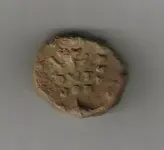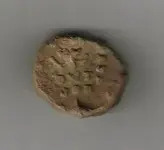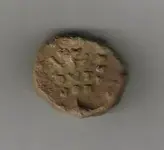You are using an out of date browser. It may not display this or other websites correctly.
You should upgrade or use an alternative browser.
You should upgrade or use an alternative browser.
any body have an idea what this is
- Thread starter PS-RI
- Start date
Monty
Gold Member
- Joined
- Jan 26, 2005
- Messages
- 10,746
- Reaction score
- 167
- Golden Thread
- 0
- Location
- Sand Springs, OK
- Detector(s) used
- ACE 250, Garrett
- Primary Interest:
- All Treasure Hunting
Put it under a sheet of paper and color over it with a pencil and maybe you can see what the figurines on it are. Is it magnetic? Monty
Upvote
0
Montana Jim
Gold Member
It looks like a lead bag seal... or lead seal for ??
Welcome to Treasure Net jps-newengland
Welcome to Treasure Net jps-newengland

Upvote
0
xlt nh
Hero Member
- Joined
- Jul 28, 2006
- Messages
- 550
- Reaction score
- 11
- Golden Thread
- 0
- Location
- Cheshire, Mass
- Detector(s) used
- White's XLT, DFX 300
I agree with Jim...lead bag seal...could be 1700s...Great find and Welcome!! 
HH, Hank 8)

HH, Hank 8)
Upvote
0
S
stefen
Guest
Bulle (bulla)
Usually a lead or wax seal used in commerce and normally found in the Near East and throughout europe...seals for documents and containers such as bags of grain...
Here is a finding related to the Pope...[edit] The "bulla" (seal)
The most distinctive characteristic of a bull was the metal seal, which was usually made of lead, but on very solemn occasions was made of gold (as Byzantine imperial deeds often were). It depicted the founders of the Church of Rome, the apostles Peter and Paul, identified by the letters Sanctus PAulus and Sanctus PEtrus. The name of the issuing pope is on the reverse side. This was then attached to the document either by cords of hemp (in the case of letters of justice, and executory) or by red and yellow silk (in the case of letters of grace) that was looped through slits in the vellum of the document. Bulla is the name of this seal, which to ancient observers looked like a bubble floating on water: Latin bullire, "to boil".
Since the late eighteenth century, the lead bulla has been replaced with a red ink stamp of Saints Peter and Paul with the reigning pope's name encircling the picture, though very formal letters, e.g. the bull of John XXIII convoking the Second Vatican Council, still receive the lead seal.
Original papal bulls exist in quantity only after the eleventh century onward when the transition from fragile papyrus to the more durable parchment was made. None survives in entirety from before 819. Some original leaden seals, however, still survive from as early as the 6th century.
Bulle have been found in many biblical archeology related sites and are used to determine dates...
Usually a lead or wax seal used in commerce and normally found in the Near East and throughout europe...seals for documents and containers such as bags of grain...
Here is a finding related to the Pope...[edit] The "bulla" (seal)
The most distinctive characteristic of a bull was the metal seal, which was usually made of lead, but on very solemn occasions was made of gold (as Byzantine imperial deeds often were). It depicted the founders of the Church of Rome, the apostles Peter and Paul, identified by the letters Sanctus PAulus and Sanctus PEtrus. The name of the issuing pope is on the reverse side. This was then attached to the document either by cords of hemp (in the case of letters of justice, and executory) or by red and yellow silk (in the case of letters of grace) that was looped through slits in the vellum of the document. Bulla is the name of this seal, which to ancient observers looked like a bubble floating on water: Latin bullire, "to boil".
Since the late eighteenth century, the lead bulla has been replaced with a red ink stamp of Saints Peter and Paul with the reigning pope's name encircling the picture, though very formal letters, e.g. the bull of John XXIII convoking the Second Vatican Council, still receive the lead seal.
Original papal bulls exist in quantity only after the eleventh century onward when the transition from fragile papyrus to the more durable parchment was made. None survives in entirety from before 819. Some original leaden seals, however, still survive from as early as the 6th century.
Bulle have been found in many biblical archeology related sites and are used to determine dates...
Upvote
0
S
stefen
Guest
As I stated earlier, bulle were commonly used to seal items of commerce and would most likely be found along coastal seaport areas bringing in goods from other U.S. ports and ports from abroad.
If it can be attributed to a particular shipper, it can be dated from as early as the founding of the original colonies to modern times.
This is where research comes into play.
There are resources that record this type of data...I would look into University Archeological Departments as a start if nothing can be found online.
You may have found a rare seal from Etheopia or other exotic location....or maybe just a 1920 electrical box seal...or maybe its a seal from a bottle of Jamacian rum...
The fun is just starting...
If it can be attributed to a particular shipper, it can be dated from as early as the founding of the original colonies to modern times.
This is where research comes into play.
There are resources that record this type of data...I would look into University Archeological Departments as a start if nothing can be found online.
You may have found a rare seal from Etheopia or other exotic location....or maybe just a 1920 electrical box seal...or maybe its a seal from a bottle of Jamacian rum...
The fun is just starting...
Upvote
0
JJS NEW ENGLAND
Full Member
- Joined
- Jun 14, 2007
- Messages
- 130
- Reaction score
- 2
- Golden Thread
- 0
- Detector(s) used
- MINELAB EXPLORER SE-- B.H LEGACY 3300 WITH 11 INCH DD COIL
I AGREE WITH ABOVE REPLIES. GREAT FIND
Upvote
0
downindixie
Hero Member
Take a knife and scratch the edge to see what its made of! A close up of it would be ideal.
Upvote
0
Montana Jim
Gold Member
plehbah said:Or blow it up with some dynamite!
You must be getting bored... these posts are looking familiar!
Upvote
0
plehbah said:Or blow it up with some dynamite!
Explosions or fire are always the proper solution to life's little mystery's.
Upvote
0
QUICKSILVER (appletree)
Hero Member
- Joined
- Mar 1, 2007
- Messages
- 971
- Reaction score
- 156
- Golden Thread
- 0
- Location
- Griffith Indiana
- Detector(s) used
- Garrett Grand Master Hunter CXlll
or ballpeen hammer and duct tape
Upvote
0
EDDE
Gold Member
- Joined
- Dec 7, 2004
- Messages
- 7,129
- Reaction score
- 65
- Golden Thread
- 0
- Detector(s) used
- Troy X5
- Primary Interest:
- All Treasure Hunting
Ramitt said:plehbah said:Or blow it up with some dynamite!
Explosions or fire are always the proper solution to life's little mystery's.
you guys forgot lots of liquorQUICKSILVER (appletree) said:or ballpeen hammer and duct tape
Upvote
0
Users who are viewing this thread
Total: 1 (members: 0, guests: 1)
Latest Discussions
-
-
Looking for a Fit buddy/partner to go into the desert mountains
- Latest: adventurewithpurpose
-
-
-
-






